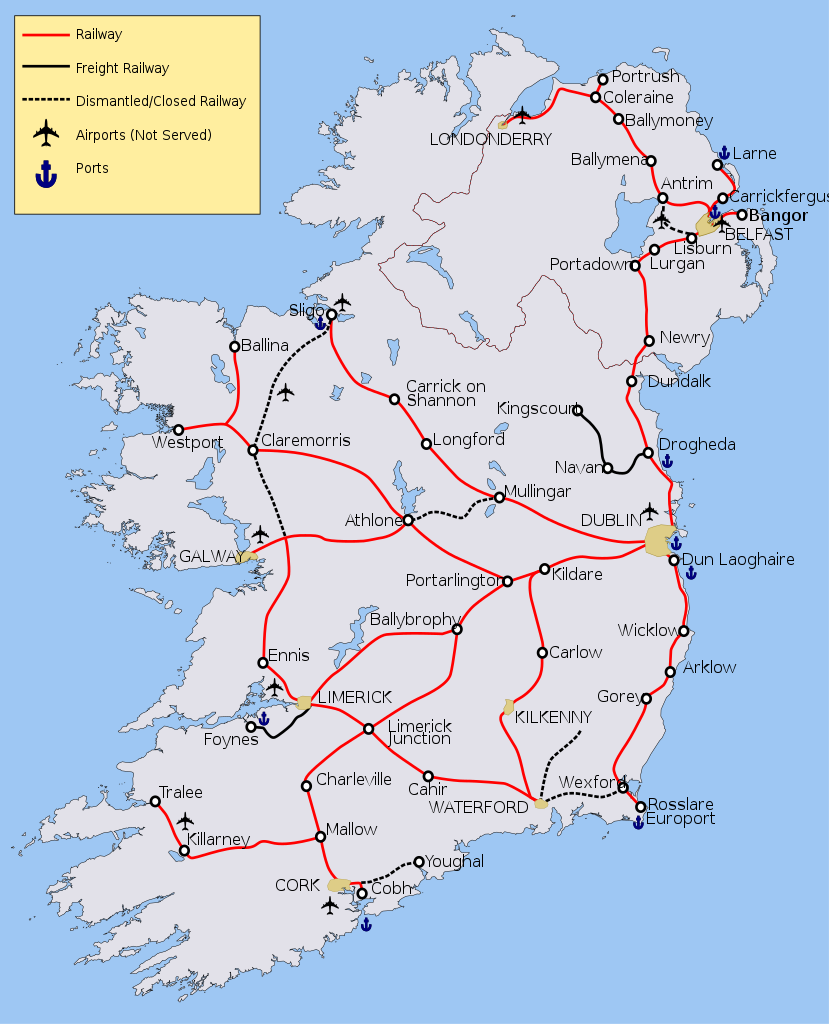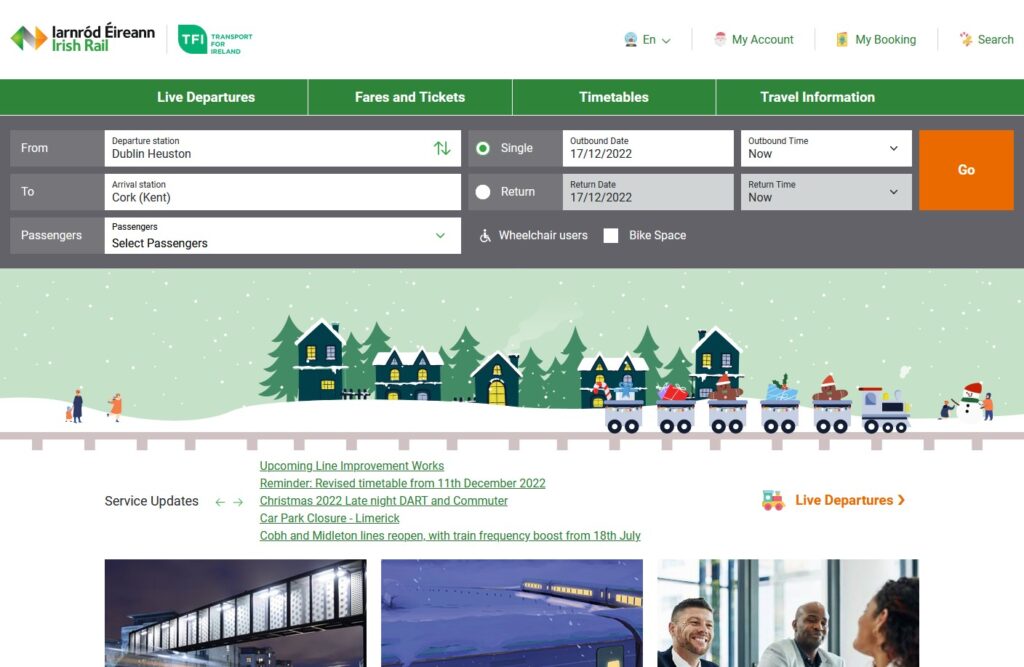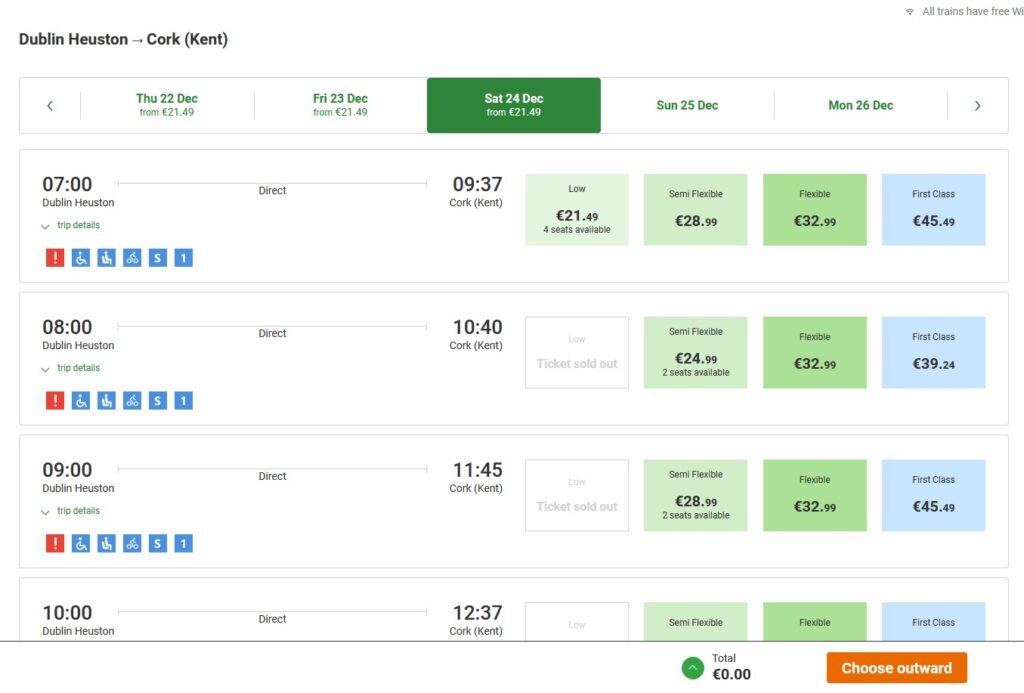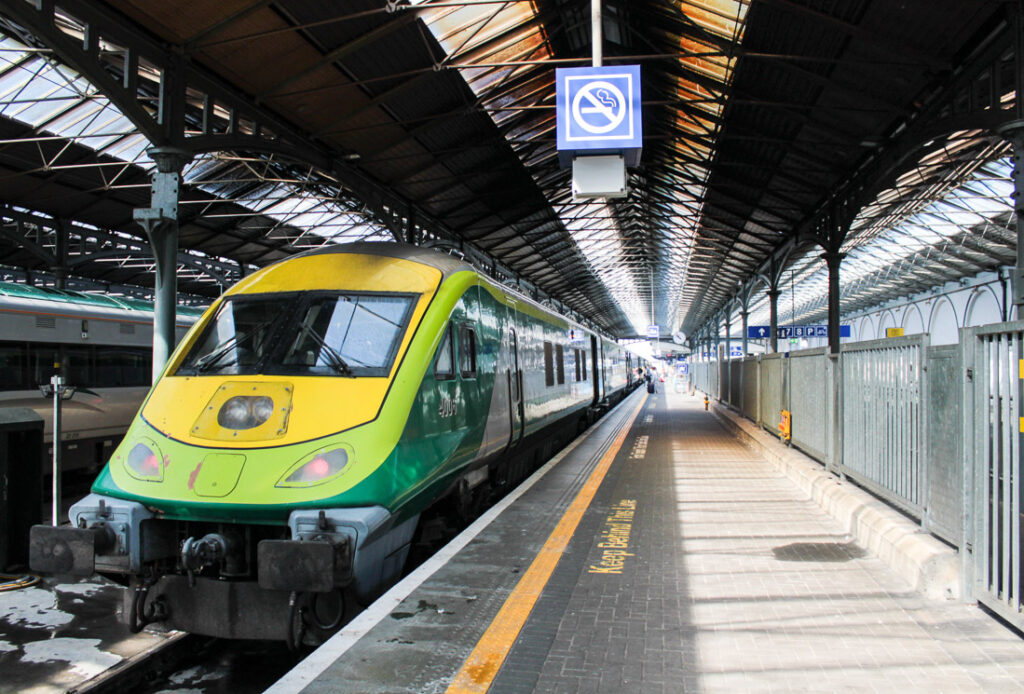The Republic of Ireland features a well maintained intercity railway network. With most major towns connected by rail from Dublin, the trains are usually a safe and comfortable way of getting around the country.
Note: This page covers traveling by intercity trains in the Republic of Ireland. For trains in Northern Ireland, please visit our dedicated info page for Northern Ireland Railways.
Where do the intercity trains run in Ireland?
Most major towns and cities are connected by rail. The Irish mainline rail network is actually 2 separate segments that converges at Dublin.

As a rule of thumb –
- Dublin Connolly: Trains along the east coast to the north (incl. Belfast), to Sligo, and Rosslare Europort.
- Dublin Heuston: Trains to the west (Athlone, Galway, Limerick, Tralee), and to the South (Waterford, and Cork).


The Irish railway network works best if you’re heading out from Dublin or vice versa as rail connections between towns outside Dublin are lacklustre due to the rationalisation exercise that took place between the 1950s and 1980s.
If you'd like to travel between towns and cities outside Dublin, consider using Bus Éireann or Expressway instead.
Who operates the trains?
The trains in Ireland are run by the state owned Iarnród Éireann (pronounced approx. “Ian-rod Air-ren”), also known as Irish Rail in English. Irish Rail is a subsidiary of Córas Iompair Éireann, which also runs most other public transport in the State.

The intercity services, branded as “InterCity”, are Irish Rail’s long distance train services to the rest of the country. While they are generally the highest tier of Irish Rail’s services, there are some regional services operated by InterCity trains with different onboard products.
Buying your intercity tickets
There are 2 ways to buy tickets for Irish Rail services – buying online, or buying at the stations. Irish Rail accepts only Euros for ticket purchases.
Buying online
The simplest way to buy Irish Rail intercity tickets is online through the Irish Rail website.
All InterCity tickets can be purchased online up to 90 days in advance. When selecting your train of choice, you will have the option of choosing between a range of 3 types of Standard Class tickets (Low Fare, Semi-Flexible, Flexible), or a First Class ticket. It is highly recommended that your purchase your tickets in advance online.


For more information and terms & conditions relating to the types of tickets sold by Irish Rail, please visit Irish Rail's Rail Tickets Explained page. Please ensure that you are familiar with the terms and conditions of the respective types of tickets before purchasing them.
Seat reservations, if available on the service, can also be made via the website when you buy your ticket. Your name or ticket number will be displayed on LED panels above the seats onboard.


It is not required to have a seat reservation, but I'd recommend you making one anyway, as if the train is overcrowded a seat reservation might be the only thing saving you from standing throughout your entire journey. Note that it is also very possible that the type of train operating your journey is changed at the last minute, and your original seat reservations will not be usable.
Remember to collect your printed tickets from the ticket machines at the station before you travel, or else you will not be able to pass through the ticket barriers at the station. To do this, you need to enter the 11 digit Ticket Collection Number that would have been emailed to you when you bought your tickets online.
Buying at the stations
Major train stations are manned and can sell you tickets. The manned counters are also a great place to get travel information if needed.
Not every ticket can be bought online. The following tickets can only be purchased in person at the station –
- Day Return tickets
- Family tickets
- Open Return tickets
- Trekker Four Day tickets (only available from the ticket counters)
- Explorer tickets (only available from the ticket counters)
A large number of train stations on the Irish rail networks are unmanned. If you’re catching a train from one such station and need a ticket, the station should have a single ticket machine available for ticket purchases.
If you’re caught in a freak situation where both the ticket counters and ticket machines are closed or unavailable, you will have to pay for your journey on the train or at your destination. The conductor will be aware that the ticket machines at the given station are inoperable, so attempting to get a free ride is not a wise choice. This is made very clear on Irish Rail’s website.
You can save a good sum of money buying your tickets online. Using the mock booking in the screenshots above as an example, you can get a one-way Low Fare Standard Class ticket for €21.49 and a First Class ticket for €45.49. If you bought an Adult Single Standard Class ticket at the station, you'd be paying €47.35 for the same route!
Buying or Upgrading to a First Class ticket
There are 2 ways to buy a First Class ticket with Irish Rail online – either you buy a First Class ticket outright, or you purchase an upgrade on top of your existing Standard Class ticket.
For more information on Irish Rail's First Class offerings, visit Irish Rail's First Class Rail Travel page
Here are the steps to getting an upgrade to First Class on Irish Rail. First, buy a Standard Class ticket at which ever tier you need.
Head back to the Irish Rail homepage. Repeat the search for trains on the same day. Click the orange “Go” button. When the train times appear, look for the “Free Travel Pass or valid ticket holders” button on the search field.

Click “Free Travel Pass or valid ticket holders“, and when the pop-up appears, select the tickets you want to upgrade.

Click “Update“, and now you’ll have to click the big orange “Go” button again. The page will then give you the familiar ticket selection interface.

You will now see the cost of the First Class supplement. In this mock booking to Cork on 24th December 2022, if we were to purchase the Low Fare Standard Class ticket for the 07:00 am Dublin Heuston departure at €21.49 and also the First Class supplement for €12.50, we’d only be paying €33.99 for a First Class ticket, some €9.30 cheaper than if we bought a First Class ticket outright for the same service.
When collecting your ticket at the station, remember also to collect your upgrade supplement ticket. You will then need to show both printed tickets to train staff onboard.
A few things to note - How much you will save is dependent on the route in question and the timing of the ticket. The upgrade is also dependent on availability and whether there is even First Class on your route. Of course, if you're not bothered about capping the costs of travel this guide isn't for you. But if you're really keen on First Class and also want some savings, this is one way to get a First Class ticket on Irish Rail for less.
Acknowledgments - Big gratitude to TravelUpdate for posting about this upgrade. Before stumbling across their post, I had been unaware that you could upgrade your tickets - Irish Rail doesn't really advertise this much. To read TravelUpdate's post on the upgrade, visit: https://travelupdate.com/secret-upgrade-trick-irish-rail/.
How are the trains like?
The intercity services are operated by modern diesel trains with different experiences onboard.
IÉ Class 22000 DMU
Irish Rail operates a large number of Class 22000 diesel multiple units made by Hyundai ROTEM between years 2007 and 2011. These units are seen everywhere on the Irish mainline network – there is usually a 100% chance that your intercity service will be operated by a Class 22000 train.


The Standard Class interior of the Class 22000 sets consist of non-reclinable seats in a 2-2 arrangement, whereas First Class on these units have a 1-2 seat arrangement using the exact same seats.. The seats have decent leg room, but can get uncomfortable for longer distance sectors. I’ve had a go on these units a few times and kept feeling an urge to stretch.


Irish Rail is presently refurbishing the cabin onboard all Class 22000 sets. The works were featured by Global Railway Review in a May 2022 article.
IÉ Mark 4 carriages
Irish Rail operates the CAF-made Mark 4 carriages exclusively on services between Dublin Heuston and Cork. These trains are hauled by a diesel locomotive with a futuristic looking Driving Van Trailer at the rear.


If these carriages and their DVT look suspiciously like they were built for speed, that’s because they were. The Mark 4 carriages were designed for speeds up to 201km/h (125mph, like the Intercity 125 in Britain), but is limited to a maximum of 160 km/h in regular operation due to track, signalling, and locomotive limitations.
The Standard Class seats on the Mark 4 carriages are somewhat more comfortable than those on the Class 22000. While the seats still can’t be reclined, they are better padded and contoured to fit the human back better than the seats on the Class 22000. First Class on the Mark 4 carriages are also much more comfortable with seats essentially being cushy armchairs on trains.

For more information on Irish Rail's First Class offerings, visit Irish Rail's First Class Rail Travel page
Can I bring my bicycle onboard intercity trains?
Yes, you can, but there are some limitations to take note of.
If you’re using foldable bicycles, there are no restrictions or extra charges to bring them onboard Irish Rail intercity trains.
If you’re bringing non-foldable bicycles (aka normal bicycles) onboard, take note of the following important restrictions –
- You must book bicycle spaces onboard in advance. Do this online when purchasing your ticket through the Irish Rail website.
- If you already have a ticket and would like to book bicycle space, use the “Free Travel Pass or Valid Ticket” method.
- There are dedicated and standalone bicycle storage areas on all Enterprise services between Dublin and Belfast (subject to last minute or unexpected changes in train equipment), and on most Dublin to Cork services.
- For all other InterCity routes, the bicycle storage area is within the passenger compartment.
- Ensure that your bicycle fits into the dedicated storage space onboard.
For the above information and more, visit Irish Rail's Bicycle Information page on the Irish Rail website.
External links
For more information and the latest travel updates, please visit –
